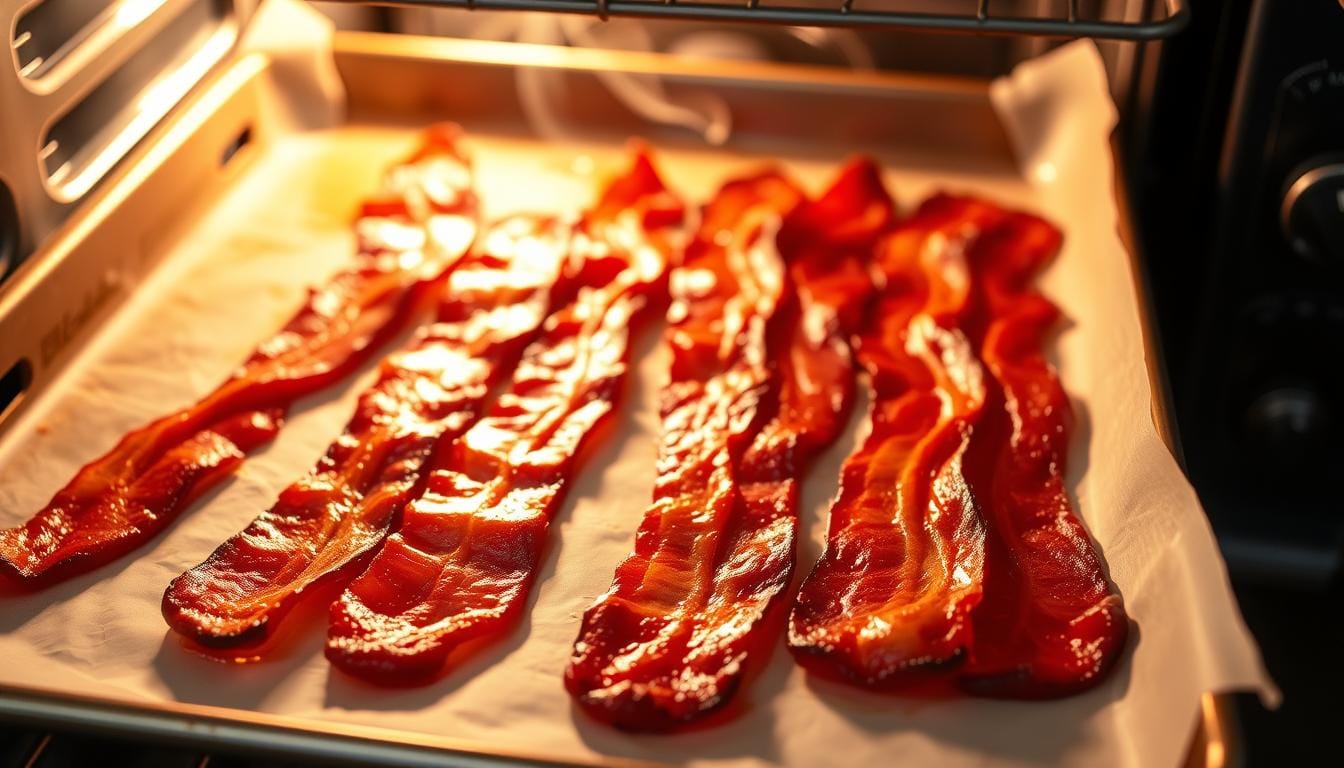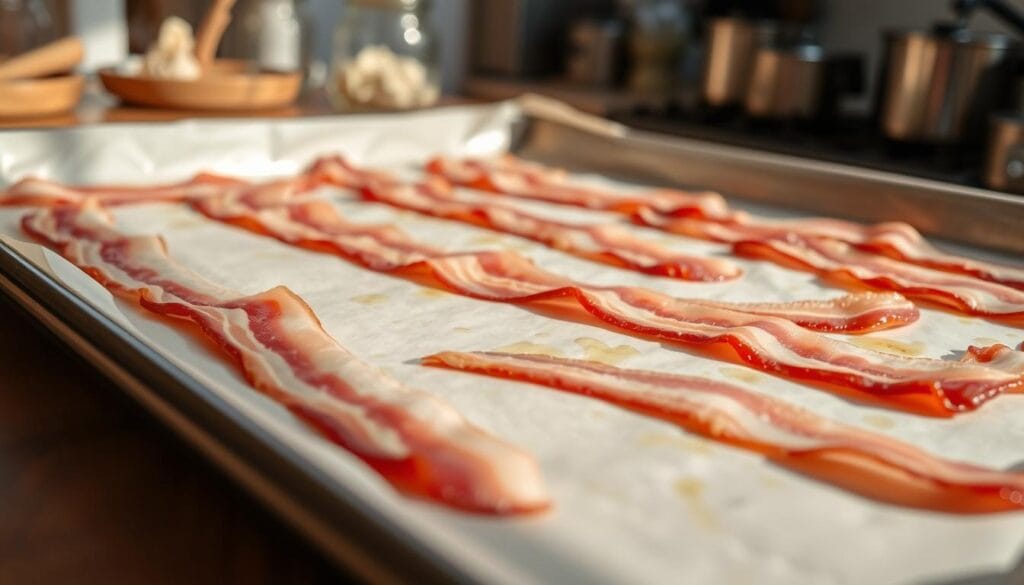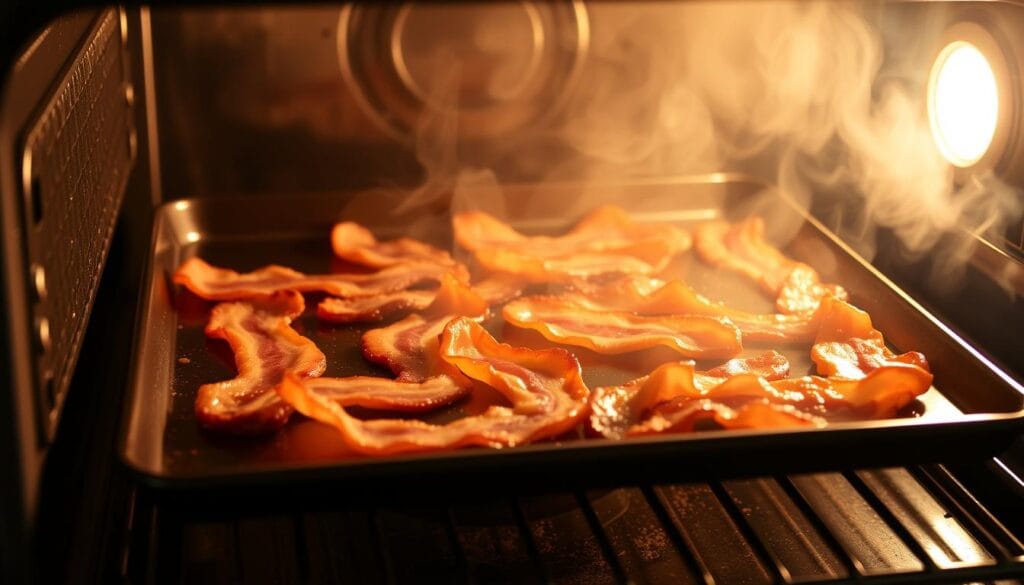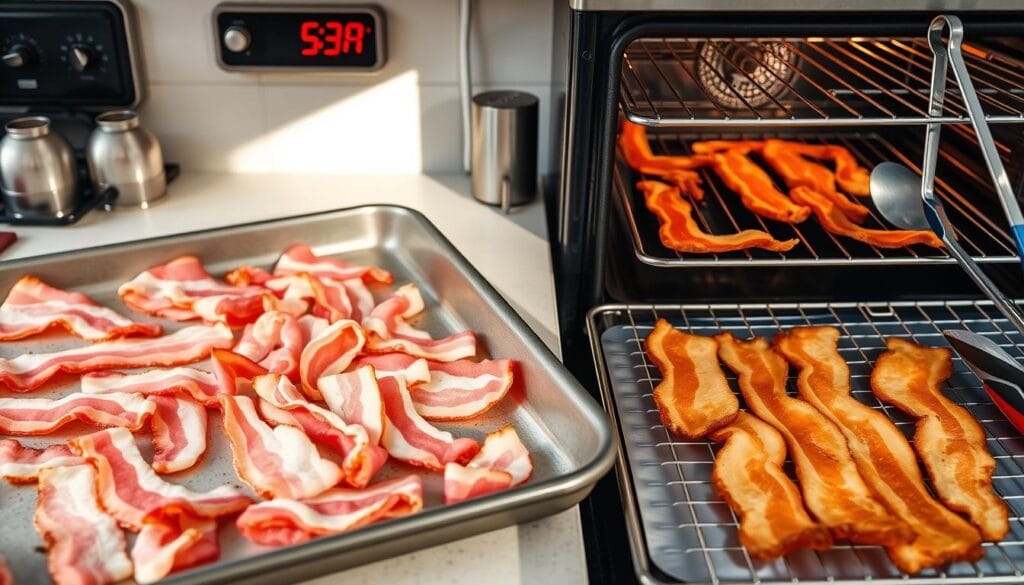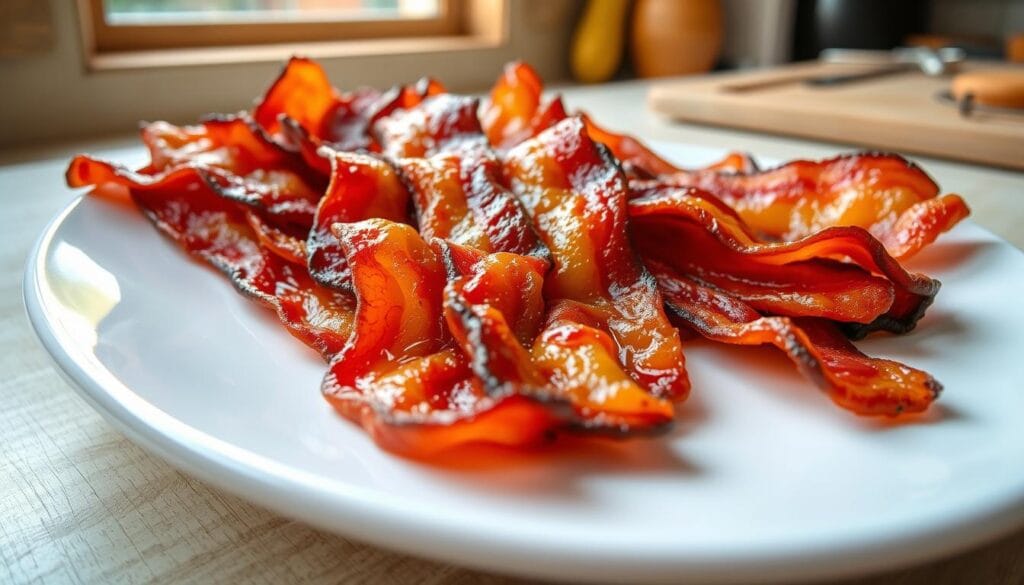I love bacon recipes, and I’ve found the best way to cook it is in the oven. It’s cleaner and easier than other methods. Plus, you can do other things in the kitchen while it cooks.
No more worries about hot grease or uneven cooking. The oven makes sure your bacon is perfectly cooked. It’s even and delicious every time.
First, heat your oven to 400°F (200°C). Then, line a baking sheet with parchment paper. Let the magic begin. In 10 to 20 minutes, you’ll have crispy bacon that’s perfect for any meal.
This method is great for making a lot of bacon. It’s perfect for big gatherings or meal prep. Say goodbye to messy stovetops and hello to easy oven-baked bacon
Why Cook Bacon in the Oven?
Cooking bacon in the oven has many benefits over stovetop methods. It’s great for making bacon recipes in large amounts, perfect for big groups or meal prep. Plus, it’s much cleaner, with less mess than stovetop cooking.
Benefits of Oven-Baked Bacon
One big plus of oven-baked healthy bacon is that you can do other things while it cooks. Just put the bacon on a baking sheet and let it cook. This way, you can focus on other parts of your meal.
The oven’s even heat makes sure the bacon cooks right every time. You won’t get burnt spots or undercooked bits. This results in crispy, delicious bacon.
Comparison to Stovetop Cooking
Stovetop cooking can be tricky, with some bacon getting too done and others not enough. Oven baking gives you more control over how crispy you want your bacon. It’s also safer, as you avoid hot oil splatters.
| Feature | Oven-Baked Bacon | Stovetop Bacon |
|---|---|---|
| Cooking Time | 15-20 minutes | 10-15 minutes |
| Crispiness Control | High | Moderate |
| Mess and Splatter | Low | High |
| Hands-Off Cooking | Yes | No |
In summary, baking bacon in the oven is cleaner, more consistent, and easier to manage. It’s a favorite among many cooks and chefs.
Choosing the Right Bacon
Choosing the right bacon is key when baking it in the oven. Different types of bacon can change how your bacon turns out. Each variety has its own taste and texture, affecting how crispy it gets.
Types of Bacon Available
- Regular Bacon: This is the classic, thin-sliced beef bacon that is a staple in most households.
- Thick-Cut Bacon: As the name suggests, this bacon is cut thicker, resulting in a meatier texture and longer cooking time.
- Center-Cut Bacon: This type of bacon is trimmed of excess fat, making it a leaner and healthier option.
- Turkey Bacon: A leaner alternative to traditional beef bacon, turkey bacon is a popular choice for those looking to reduce their intake of saturated fat.
Thick Cut vs. Standard Cut
Choosing between thick-cut and standard-cut bacon depends on what you like and your recipe. Thick-cut bacon needs a bit more time in the oven, about 5-10 minutes more. Standard-cut bacon cooks faster and more evenly, perfect for recipes where you want crispy bacon all over.
| Bacon Type | Cooking Time in Oven | Texture |
|---|---|---|
| Thick-Cut Bacon | 25-30 minutes | Meatier, chewier |
| Standard-Cut Bacon | 20-25 minutes | Crispy throughout |
When picking bacon for baking, think about what you like, the texture you want, and your recipe. Trying different bacons can also be fun, letting you find new tastes and textures.
“Bacon is the candy of meats.” – Unknown
Essential Tools for Oven Bacon
To make tasty baked bacon in the oven, you need a few basic tools. You’ll need a rimmed baking sheet, parchment paper or aluminum foil, and an optional oven-safe cooling rack.
Baking Sheets and Racks
A sturdy rimmed baking sheet is key for oven cooking methods like baking bacon. Choose sheet pans that are thick and won’t warp in the oven’s heat. The edges catch grease that drips off the bacon.
An oven-safe cooling rack on the baking sheet is optional but helpful. It lets hot air circulate under the bacon for even cooking and crispiness.
Parchment Paper and Foil
Using parchment paper or aluminum foil on your baking sheet makes cleanup easy. The bacon won’t stick, and you can just toss the lining after cooking. This makes cleaning up the fat simple.
Some prefer to cook bacon directly on the sheet pan without lining. This method requires more effort to clean off the grease.
Preparing the Baking Sheet
Cooking bacon preparation techniques right starts with the baking sheet. To get that perfect crisp, follow these steps for easy cleanup and better airflow.
Lining the Sheet for Easy Cleanup
Put parchment paper or aluminum foil on your baking sheet. This keeps the pan clean from grease and stains. It also makes cleaning up easy. Plus, you can pour the bacon preparation techniques into a container for later.
The Importance of Airflow
Using foil or parchment is key, but adding a wire rack takes it up a notch. The rack helps air circulate around the bacon. This makes each slice crispy and evenly cooked.
Good air flow is key for easy bacon cooking. Elevating the bacon on a wire rack lets hot air circulate. This ensures every slice is perfectly crisp.
“Lining the baking sheet and using a wire rack are two simple steps that can transform your bacon preparation techniques and take your oven-baked bacon to new heights of crispiness.”
How to Arrange the Bacon
Getting the perfect crispy bacon in the oven starts with how you lay the slices. It’s important to place them in a single layer, without any overlap. This way, the heat can reach each slice evenly, making them crispy.
Single Layer Technique
Place the bacon slices side by side on a baking sheet or a wire rack over a sheet. Make sure they don’t touch each other. This prevents uneven cooking and helps them get crispy.
Avoiding Overlapping
Don’t pack the bacon too tightly together. Overlapping can cause some slices to cook unevenly. This leads to some being crispy while others are soft. By keeping them apart, you get crispy bacon all around.
For perfectly crispy bacon, arrange them in a single layer without overlap. This lets the heat circulate freely, making each slice crispy and delicious.
Optimal Oven Temperature
For cooking bacon in the oven, use 400°F (200°C) for all types. This temperature is perfect for rendering fat and getting a crispy, golden-brown finish. Start with a cold oven to ensure the bacon fat renders well.
Recommended Temperatures for Crispy Bacon
400°F is the best temperature for crispy bacon. It balances fat rendering and edge crispiness, cooking bacon in about 20 minutes. Thicker slices might need 25-30 minutes for the right crispiness.
Adjusting for Different Oven Types
Every oven cooks differently, so adjust temperature and time as needed. For convection ovens, lower the temperature by 25°F. This helps with the efficient heat circulation.
| Oven Type | Recommended Temperature | Cooking Time |
|---|---|---|
| Conventional Oven | 400°F (200°C) | 20-30 minutes |
| Convection Oven | 375°F (190°C) | 18-25 minutes |
Keep in mind, the best temperature and time can change based on bacon thickness, oven type, and your crispiness preference. Try different settings to find your perfect bacon.
Cooking Time for Bacon
To get crispy bacon in the oven, timing is key. The time needed depends on how thick your bacon slices are. For regular bacon, bake at 400°F (200°C) for 12-18 minutes. If your bacon is thicker, it might take 20 minutes or more to get it crispy.
Timing for Different Thicknesses
- American bacon: Cook for 12-18 minutes, checking early as thinner slices cook faster.
- Thick-cut bacon: Cook for 20 minutes or as needed, thicker slices may require additional time.
- Turkey bacon: Cook for 11-13 minutes.
Checking for Doneness
Begin checking your bacon at the 10-minute mark. Then, check every few minutes after. It’s done when it’s a deep, dark tan. Remember, it will crisp up more as it cools. To ensure even browning, rotate the baking sheet halfway through.
| Nutrient | Amount per Serving |
|---|---|
| Calories | 230 |
| Protein | 6g |
| Fat | 21g |
| Saturated Fat | 7g |
| Cholesterol | 36mg |
| Sodium | 365mg |
| Potassium | 109mg |
| Vitamin A | 20IU |
| Calcium | 3mg |
| Iron | 0.2mg |
The cooking time can change based on bacon thickness and brand. Always watch your bacon closely to get it just right.
Flipping Bacon: Is It Necessary?
When cooking bacon in the oven, you might wonder if you should flip it. The answer depends on how you cook it. If you use a baking rack, flipping is not needed. But, if you cook it directly on a baking sheet, flipping halfway can help it cook evenly.
Pros and Cons of Flipping
Flipping bacon can make it brown and crisp more evenly. It exposes the uncooked side to the oven’s heat. But, it requires more attention and can lead to burns from hot grease.
Signs It’s Time to Flip
- Uneven coloring: If some parts of the bacon brown faster, it’s time to flip.
- Curling bacon: If the bacon’s edges curl up, flipping can prevent this and ensure even cooking.
Whether to flip bacon or not depends on your preference and cooking method. Cooking on a baking rack without flipping is easy and hands-off. But, for perfectly crisp bacon, flipping halfway can be worth it.
Flavoring and Seasoning Options
Make your oven-baked bacon taste amazing by trying different spices and seasonings. You can go from savory to sweet, making bacon a versatile ingredient.
Adding Spices for Extra Flavor
Begin with simple spices like black pepper or garlic powder to enhance the bacon’s taste. For a spicy kick, add a bit of cayenne pepper or paprika. Try chili powder or cumin for a Southwestern flavor.
Sweet vs. Savory Options
- For a sweet and smoky taste, brush bacon with brown sugar and maple syrup before baking.
- Want something savory? Rub bacon with herbs de Provence, rosemary, or thyme for a unique aroma.
- Try mixing honey and soy sauce for a sweet and salty flavor that’s irresistible.
There are countless ways to flavor your oven-baked bacon recipes and bacon preparation techniques. Be creative with your seasonings and have fun.
| Flavor Profile | Ingredients | Nutritional Info (per serving) |
|---|---|---|
| Maple Chili | 1 tbsp chili garlic sauce | Calories: 366 Carbs: 53g Protein: 5g Fat: 16g |
| Honey Chipotle | 1 tsp chipotle powder | Calories: 366 Carbs: 53g Protein: 5g Fat: 16g |
| Pepper Brown Sugar | 1/3 cup brown sugar, 1 1/2 tsp black pepper | Calories: 366 Carbs: 53g Protein: 5g Fat: 16g |
| Honey Sesame | 1/4 cup honey, 1 tsp sesame oil, 1 tsp sesame seeds | Calories: 366 Carbs: 53g Protein: 5g Fat: 16g |
For the best taste, use high-quality, thick-cut bacon. Adjust cooking times to get your bacon just right.
How to Store Cooked Bacon
After mastering cooking bacon in the oven for that perfect crisp, you’ll want to store leftovers. Knowing how to store bacon is crucial. It keeps your bacon fresh and tasty for future meals.
Refrigerating Leftover Bacon
Let cooked bacon cool before putting it in an airtight container. This way, it can stay good in the fridge for up to 5 days. To reheat, warm it gently in a skillet or microwave in short bursts.
Freezing for Long-Term Storage
Freezing cooked bacon is great for longer storage. Freeze bacon strips on a baking sheet until firm. Then, put them in a freezer bag or airtight container. Frozen bacon stays fresh for a month. Just thaw it in the fridge before reheating.
| Storage Method | Shelf Life | Reheating Recommendations |
|---|---|---|
| Refrigerator | Up to 5 days | Gently heat in a skillet over low heat or in the microwave in 15-second bursts |
| Freezer | Up to 1 month | Thaw in the refrigerator before reheating in a skillet or oven |
By following these tips, you can enjoy your bacon recipes and easy bacon cooking for weeks.
Serving Suggestions
Mastering the art of cooking crispy, oven-baked bacon recipes opens up endless serving options. Enjoy your perfectly cooked bacon with classic breakfast items like eggs, pancakes, or waffles. Or, use your bacon in tasty dishes all day long.
Breakfast Ideas Featuring Bacon
- Crumble bacon over fluffy pancakes or golden waffles.
- Wrap bacon around breakfast sausages for a savory twist.
- Add bacon to omelets or scrambled eggs for a protein-packed breakfast.
- Serve bacon alongside avocado toast for a flavor-packed start to the day.
Creative Uses in Other Meals
- Top your favorite salads with crispy bacon bits for a satisfying crunch.
- Wrap bacon around asparagus spears or dates for a delicious appetizer.
- Sprinkle bacon over baked potatoes or creamy soups for added flavor and texture.
- Incorporate bacon into pasta dishes, such as carbonara or mac and cheese.
- Wrap bacon around chicken or beef for a flavorful main course.
Remember to save the flavorful bacon grease for cooking eggs or adding extra depth to other dishes. With endless possibilities, crispy bacon tips can make any meal better.
Troubleshooting Common Issues
Cooking bacon in the oven is easy and quick, but sometimes you might face a few problems. Let’s look at how to fix these issues so your bacon always comes out crispy.
Bacon Sticking to the Pan
Is your bacon sticking to the baking sheet? There’s a simple fix. Use parchment paper or a non-stick baking sheet. This makes cleanup easier and helps the bacon come off the pan without sticking.
Achieving Desired Crispiness
To get the crispiest bacon, try cooking it on a wire rack on the baking sheet. This lets the fat drip off, making the bacon crunchy. If your bacon isn’t crispy enough, cook it for a bit longer, in 2-3 minute intervals.
For even crisper bacon, start with a cold oven. Let the bacon cook as the oven warms up. Also, flipping the bacon halfway through cooking helps it brown evenly and get crispy.
FAQ
What are the benefits of cooking bacon in the oven?
Cooking bacon in the oven has many perks. It makes bacon crispy and evenly cooked. It’s also cleaner, with less splatter. Plus, you can do other kitchen tasks while the bacon bakes.
How does oven-baked bacon compare to stovetop cooking?
Oven-baked bacon cooks more evenly than stovetop bacon. It avoids hot spots and charring. The oven method is also easier, needing no constant flipping or attention.
What type of bacon is best for oven-baking?
Center-cut bacon is best for even thickness. Thick-cut bacon takes longer to cook. Standard-cut bacon cooks faster and more evenly. Choose based on your preference and recipe needs.
What tools are essential for oven-baking bacon?
You’ll need a rimmed baking sheet and paper towels for draining. An oven-safe cooling rack is optional. Heavy-duty baking sheets and parchment paper or foil make cleanup easier.
How should I arrange the bacon on the baking sheet?
Place bacon slices in a single layer on the sheet or rack. Make sure they don’t overlap for even cooking. Place them side-by-side without touching for crispiness.
What is the recommended oven temperature for cooking bacon?
Use 400°F (200°C) for regular and thick-cut bacon. Start with a cold oven for better fat rendering. Adjust times and temperatures for your oven. For convection ovens, lower the temperature by 25°F.
How long should I cook the bacon in the oven?
Cook bacon for 10-20 minutes, depending on thickness and crispiness. Thick-cut bacon may need 5-10 more minutes. Check at 10 minutes, then every few minutes after. It’s done when it’s dark tan.
Is it necessary to flip the bacon during cooking?
Flipping bacon is not needed on a rack. If on a sheet, flip halfway for even cooking. Flipping requires more attention and can lead to burns from hot grease.
Can I add seasonings or flavorings to the bacon?
Yes, you can add spices like black pepper, brown sugar, or maple syrup. Try garlic powder, paprika, or cayenne for savory flavors. Brown sugar or maple syrup add sweetness. Apply seasonings before baking for best flavor.
How do I store leftover cooked bacon?
Store cooked bacon in an airtight container in the fridge for up to five days. Freeze it for longer storage. Reheat in a skillet or microwave in 15-second bursts. Frozen bacon thaws in the fridge before reheating.

